Why you can trust Tom's Hardware
Comparison Products
We're going to toss the Acer FA100 up against some of the best NVMe SSDs available. We'll include the Samsung 970 EVO Plus, SK hynix Gold P31, Samsung 980, Crucial P5, WD Black SN750, and WD Blue SN550.
Game Scene Loading - Final Fantasy XIV
Final Fantasy XIV Shadowbringers is a free real-world game benchmark that easily and accurately compares game load times without the inaccuracy of using a stopwatch.
Acer’s FA100 isn’t the fastest SSD for loading up your games, but still delivers acceptable load times overall. The Acer FA100 scored the slowest load times in this bunch, trailing the closest competitor by roughly a second and the first-place ranking SK hynix Gold P31 by a solid three-and-a-half seconds.
Transfer Rates – DiskBench
We use the DiskBench storage benchmarking tool to test file transfer performance with a custom dataset. We copy a 50GB dataset including 31,227 files of various types, like pictures, PDFs, and videos to a new folder and then follow-up with a reading test of a newly-written 6.5GB zip file.


Once again, the FA100 struggles to compete with the best. Although it beat the WD Blue SN550 by an average of roughly 100 MBps, Acer’s FA100 still scored the second-slowest result when tasked with our 50GB file copy. When reading back our .zip file, it fell behind the pack, even the WD Blue SN550, landing in last place.
Trace Testing – PCMark 10 Storage Test
PCMark 10 is a trace-based benchmark that uses a wide-ranging set of real-world traces from popular applications and everyday tasks to measure the performance of storage devices. The quick benchmark is more relatable to those who use their PCs for leisure or basic office work, while the full benchmark relates more to power users.




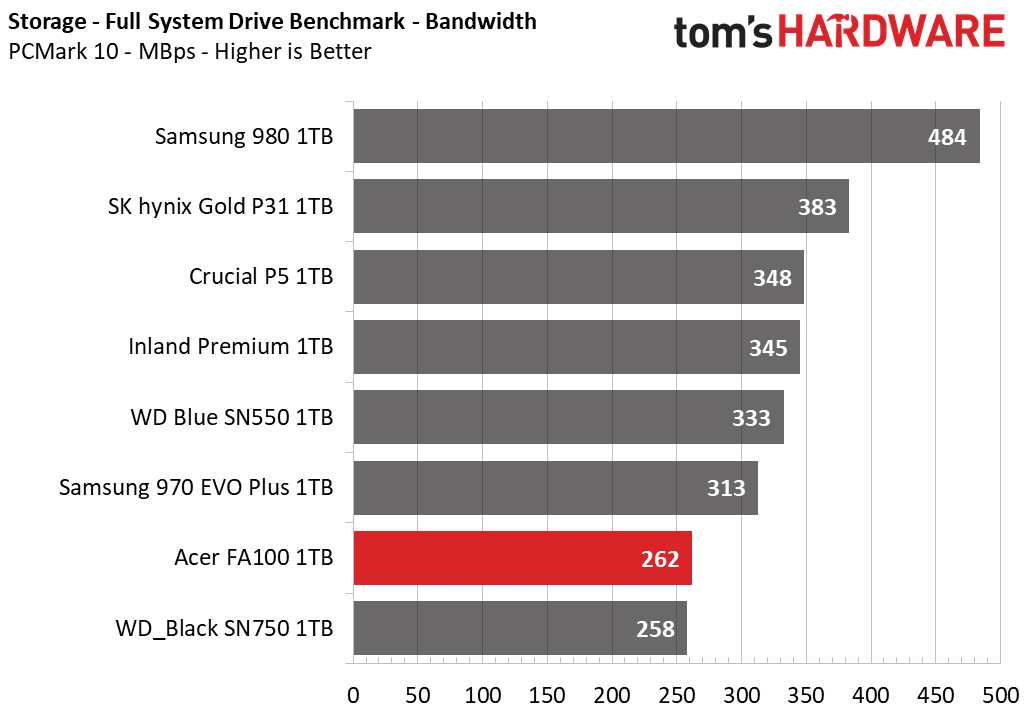

Thanks to very fast random performance at low queue depths (QDs), the Acer FA100 outperforms both the Samsung 970 EVO Plus and WD_Black SN750 when hit with PCMark 10’s Quick System Drive benchmark. However, it still trails the rest of the competitors here. When tasked with the Full System Drive benchmark, the FA100 fell behind the Samsung into second-to-last place, essentially tying the WD_Black SN750.
Get Tom's Hardware's best news and in-depth reviews, straight to your inbox.
Synthetic Testing - ATTO / CrystalDiskMark
ATTO and CrystalDiskMark (CDM) are free and easy-to-use storage benchmarking tools that SSD vendors commonly use to assign performance specifications to their products. Both of these tools give us insight into how each device handles different file sizes.
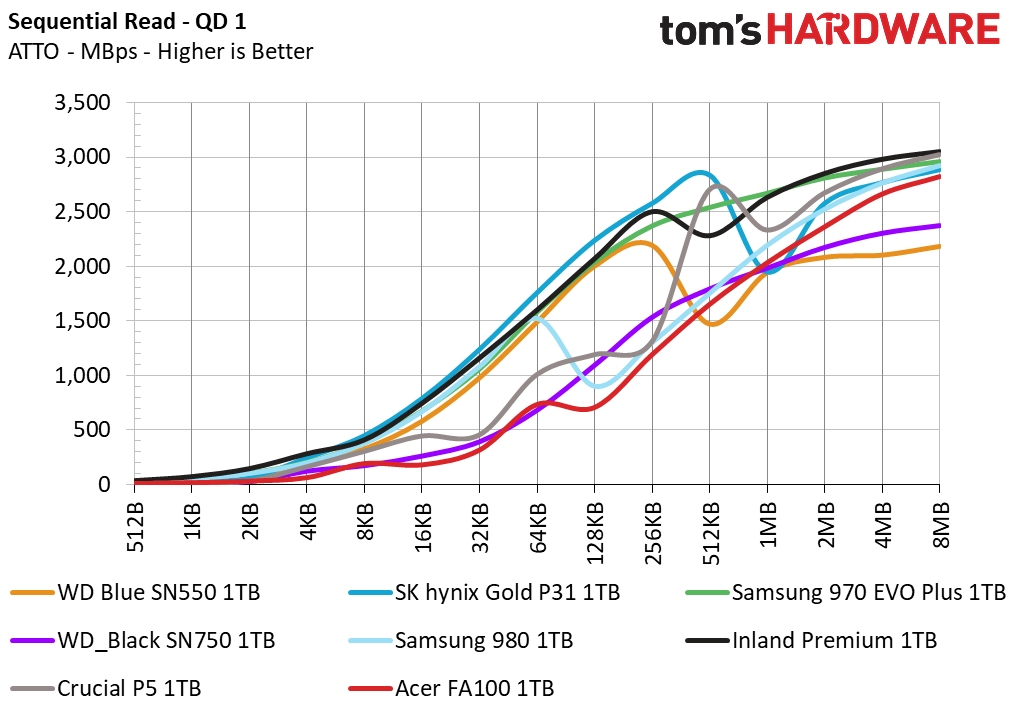

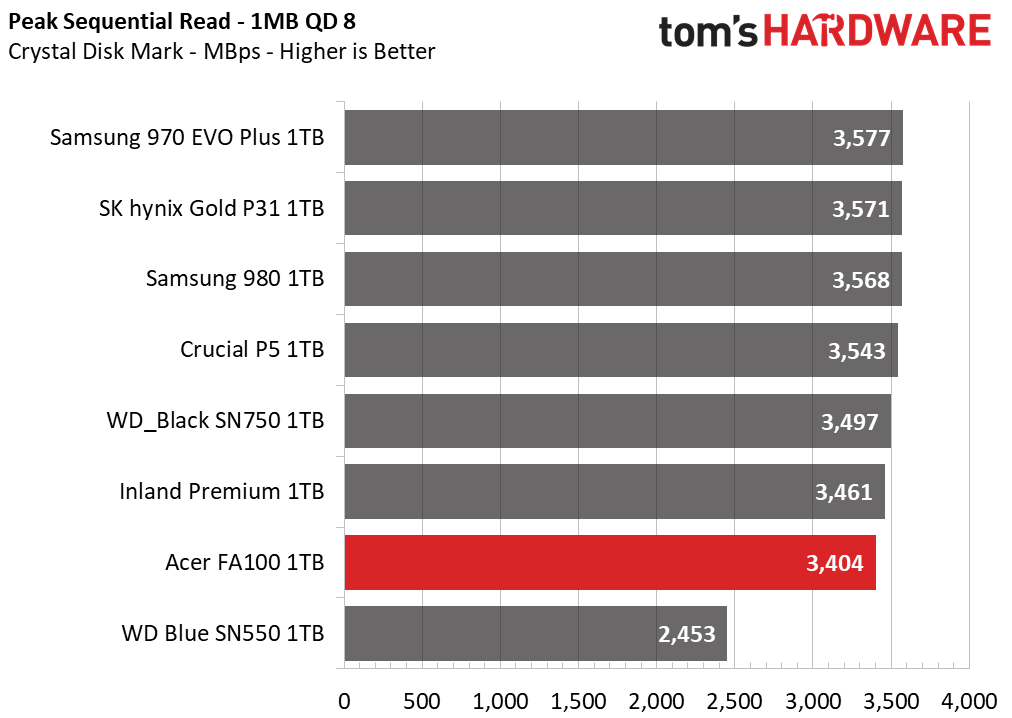
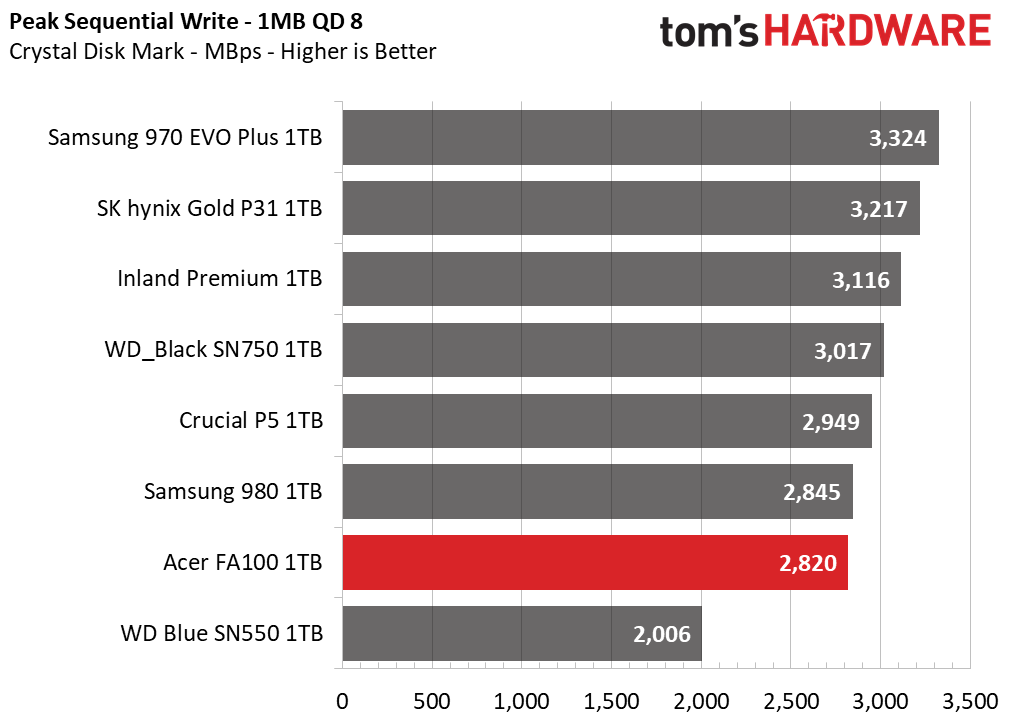





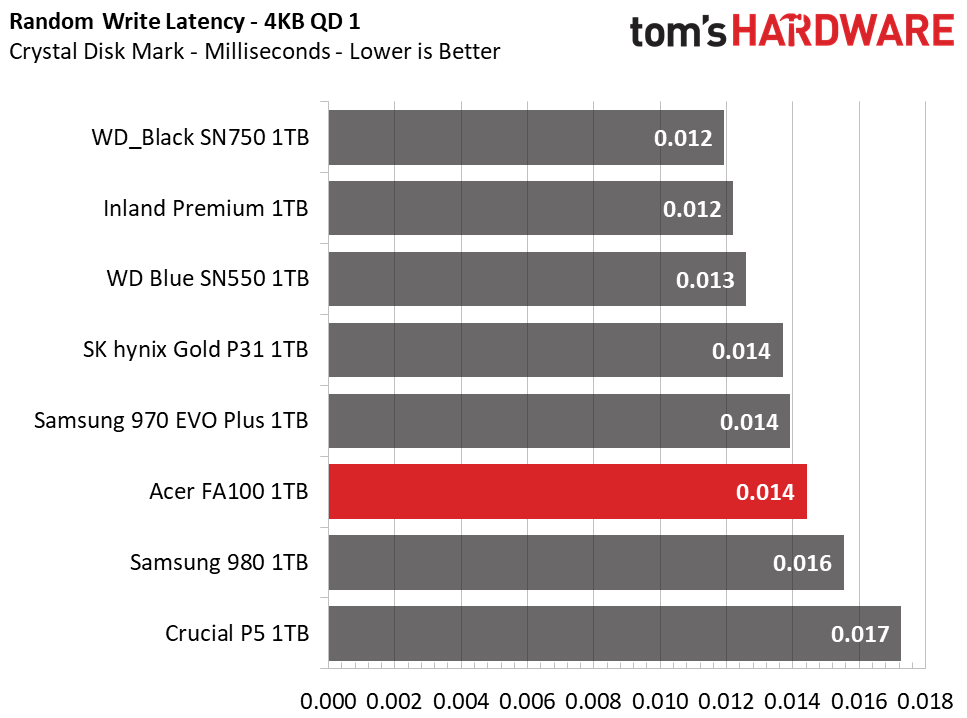




In ATTO, Acer’s FA100 is among the slowest SSDs when tested at smaller block sizes. However, random performance looks fairly strong at low QDs. At a queue depth of 1, the FA100 trails the Samsung 980 and SK hynix Gold P31, but outperforms high-end SSDs such as the Crucial P5, Samsung 970 EVO Plus, and WD_Black SN750. When upping the workloads to higher queue depths, however, the Acer FA100 falls behind most competitors.
Sustained Write Performance and Cache Recovery
Official write specifications are only part of the performance picture. Most SSDs implement a write cache, which is a fast area of (usually) pseudo-SLC programmed flash that absorbs incoming data. Sustained write speeds can suffer tremendously once the workload spills outside of the cache and into the "native" TLC or QLC flash. We use iometer to hammer the SSD with sequential writes for 15 minutes to measure both the size of the write cache and performance after the cache is saturated. We also monitor cache recovery via multiple idle rounds.


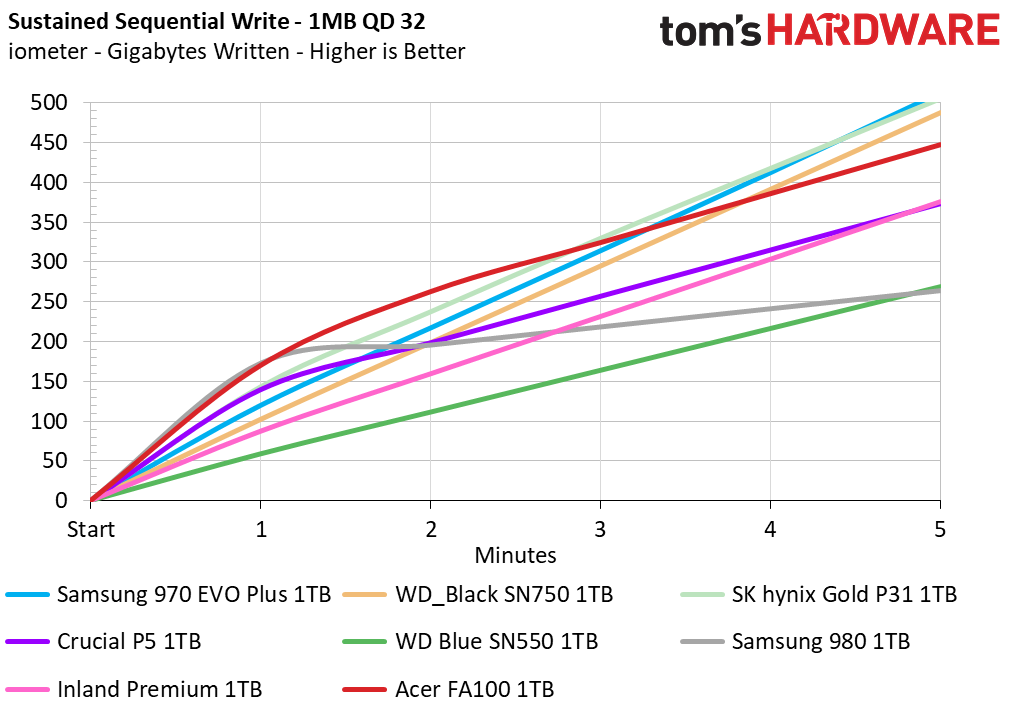


In terms of sustained write performance, the FA100 displayed decent performance given its DRAM-less design. The FA100’s write performance degraded from 2.8 GBps to 1 GBps after writing 218GB of data. After writing an additional 413GB, the FA100’s write performance degraded once again to 230 MBps on average.But the Acer drive features solid SLC cache recovery. The FA100 recovered 44GB of data within five minutes of idle time and reclaimed nearly the full SLC cache after half an hour.
Power Consumption and Temperature
We use the Quarch HD Programmable Power Module to gain a deeper understanding of power characteristics. Idle power consumption is an important aspect to consider, especially if you're looking for a laptop upgrade. Some SSDs can consume watts of power at idle while better-suited ones sip just milliwatts. Average workload power consumption and max consumption are two other aspects of power consumption, but performance-per-watt is more important. A drive might consume more power during any given workload, but accomplishing a task faster allows the drive to drop into an idle state more quickly, ultimately saving energy.
We also monitor the drive’s temperature via the S.M.A.R.T. data and an IR thermometer to see when (or if) thermal throttling kicks in and how it impacts performance. Bear in mind that results will vary based on the workload and ambient air temperature.




In terms of power efficiency, Acer’s FA100 compared well. Under load, the FA100 turned in the second-highest score, with the least amount of power consumed. Peak power consumption is well regulated, but when plugged in our desktop test bench and resting at idle, it consumed the second-most power in the group, roughly 1W.
At idle, the FA100’s controller measured 46 degrees Celsius and when tasked with various workloads, remained cool throughout. After writing over 400GB straight, the FA100’s temperature peaked at 76 degrees Celsius. In most situations, the FA100 will remain cool without additional cooling.
Test Bench and Testing Notes
| CPU | Intel Core i9-11900K |
| Motherboard | ASRock Z590 Taichi |
| Memory | 2x8GB Kingston HyperX Predator DDR4 5333 |
| Graphics | Intel UHD Graphics 750 |
| CPU Cooling | Alphacool Eissturm Hurricane Copper 45 3x140mm |
| Case | Streacom BC1 Open Benchtable |
| Power Supply | Corsair SF750 Platinum |
| OS Storage | WD_Black SN850 2TB |
| Operating System | Windows 10 Pro 64-bit 20H2 |
We use a Rocket Lake platform with most background applications such as indexing, windows updates, and anti-virus disabled in the OS to reduce run-to-run variability. Each SSD is prefilled to 50% capacity and tested as a secondary device. Unless noted, we use active cooling for all SSDs.
Conclusion
While Micron’s B47R TLC has proven fast and capable, when paired with InnoGrit’s IG5216 on the FA100 today, it wasn’t in its best representation. Acer’s FA100 is overall one of the slower NVMe drives we’ve come across. Although it delivers good sequential performance, without onboard DRAM it lagged the competition under most workloads.
On the other hand, the FA100 proved efficient and ran cool during most tasks, and it's priced low. At just $105 for the 1TB capacity, the FA100 is well-positioned. It costs just $10 more than the WD Blue SN550 and undercuts its higher-performing competition as it should. That said, for just $10-15 more, the Crucial P5 and WD_Black SN750 make for compelling alternatives to those who value onboard DRAM for faster and more consistent performance.
MORE: Best SSDs
MORE: How We Test HDDs And SSDs
MORE: All SSD Content

Sean is a Contributing Editor at Tom’s Hardware US, covering storage hardware.
-
Alvar "Miles" Udell At $90 right now at Amazon, I'd say it's the perfect upgrade for a laptop given its performance per watt.Reply -
SyCoREAPER Really not the "low price" I was expecting. Best Buy often has sales on better NVMe drives for the same price.Reply
If you need it NOW and can't wait for a sale I guess it would do but definitely wouldn't be my first choice.

